The local narrow-gauge railway in the Maggia valley was already seriously threatened with closure when Daniel Heer travelled to Ticino, probably in 1964 or 1965, to photograph it. Unfortunately, the large-format negatives have not yet been documented as meticulously as his later 35mm photographs. However, our Ticino colleague Sebastiano Mattei was able to locate the shooting locations and supplement the images with interesting information.
This narrow-gauge railway began operating in 1907 as Ferrovie elettrica Locarno – Ponte Brolla – Bignasco (Locarno – Ponte Brolla – Bignasco electric railway) LPB. From a technical point of view, it had some unique features. The line started next to the SBB railway station in Locarno and initially ran through the city of Locarno on tracks shared with the Locarno tram, which was electrified with 800V 20Hz alternating current and began operating shortly afterwards. Outside the city area, the alternating voltage was significantly increased and fed in at 5000V 20Hz in order to reduce losses over longer distances. For this purpose, two different high-voltage feeds were available at the railcar’s transformer. This was the first commercial application of electric alternating current traction, which was tested by MFO on the Wettingen-Seebach test track, and some of the technology was adopted, such as the lateral catenary with the rod-shaped curved pantograph. The railway was used for passenger and freight transport, which was dominated by the transport of granite from the Riveo quarry.
In 1923, the Centovalli Railway Locarno–Domodossola was opened with 1200 V direct current, sharing the first 10 km of the line to Ponte Brolla with the Maggia Valley Railway. In order to continue offering through trains, the Maggia Valley Railway was electrified in 1925/26. The original LPB railcars 1–3 were fitted with new DC electrical equipment by BBC, with a pantograph in the middle of the car. However, the curious bow pantograph remained in use from Ponte Brolla onwards. During the conversion period, two steam locomotives G 3/4 7 and 8 from the Rhaetian Railway (RhB) (and others) were in service.
Forty years later, the Maggia Valley Railway was badly worn out, as investments had been made almost exclusively in the main line to Domodossola, and it was facing increasing difficulties in the face of competition from cars. The political climate at the time saw buses as the way forward and opposed the modernisation of railways. Sadly, the last train ran in 1965. The bus ran nine times a day, the same frequency as the railway had previously.
It is striking that the same train was photographed several times as it travelled through the characteristic landscapes of the valley along the entire route. Either Daniel Heer was travelling by car, or he was on a photo trip with like-minded people. The composition of the train and the times of day indicate that it was train 442, which is why we have commented on this assumption in the captions.
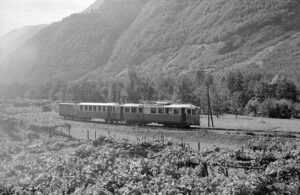
Photo: Daniel Heer@bahnarchiv.ch_ SGEG_DH_A_SWN120_FART-007
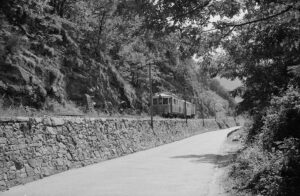
The former railway line is still clearly visible today and is used as a separate cycle path.
Photo: (c) Daniel Heer/bahnarchiv.ch, SGEG DH A SWN120 FART-008
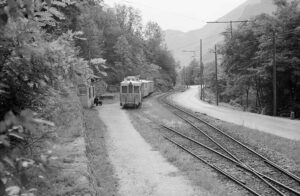
Photo: (c) Daniel Heer/bahnarchiv.ch, SGEG DH A SWN120 FART-005

The journey time was 1 hour and 30 minutes for just under 30 km (although according to the timetable, it was 43 km). Thanks to the covered freight wagon K103, train 442 also took over freight transport.
On public holidays, when freight transport was suspended, the train, renamed 444, was accelerated by 18 minutes.
Photo: (c) Daniel Heer/bahnarchiv.ch, SGEG DH A SWN120 FART-006

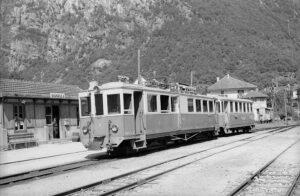
The departure as train 449 is not scheduled until 12:35 p.m., so there is more than an hour’s break.
Photo: (c) Daniel Heer/bahnarchiv.ch, SGEG DH A SWN120 FART-012

The railway crossed the cantonal road several times, which played against it when the decision was made to modernise or discontinue operations. Photo: (c) Daniel Heer/bahnarchiv.ch, SGEG DH A SWN120 FART-012a
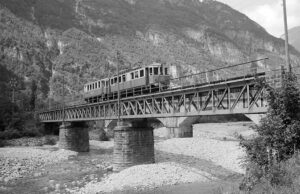
The bridge has been preserved to this day… Photo: (c) Daniel Heer/bahnarchiv.ch, SGEG DH A SWN120 FART-013

In 2020, it was repaired and has since been used for bicycle and pedestrian traffic.
The bridge gained a certain degree of fame in 2024 when, after the collapse of the neighbouring road bridge during the storm of 29/30 June 2024, it remained the only connection to the upper part of the Maggia Valley for several weeks and was also used by cars and light delivery vans in single-lane traffic. 15 October 2006 Photo: (c) Edi Meier, Bülach
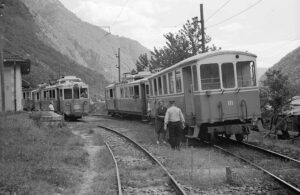
Passengers had to alight directly onto the ballast, as there is no platform. It is interesting to note that on this day, the two non-modernised railcars 2 and 3 were in service. Photo: (c) Daniel Heer/bahnarchiv.ch, SGEG DH A SWN120 FART-
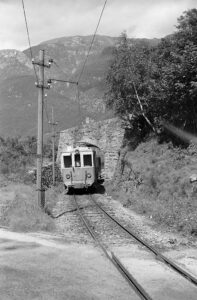
Photo: (c) Daniel Heer/bahnarchiv.ch, SGEG DH A SWN120 FART-019
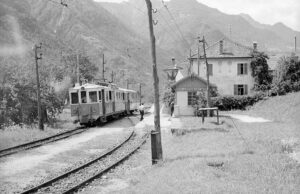
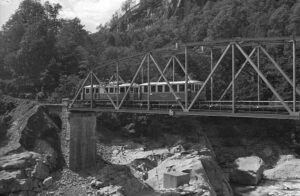
Photo: (c) Daniel Heer/bahnarchiv.ch, SGEG DH A SWN120 FART-020
Comments and additions to this railway history can be sent to EG at sgeg dot ch, or use the form to our Vice President Edi Meier. Thank you for your help.
Back to railway stories.